4" snow on the ground at MSP
38 F. high temperature in the Twin Cities Friday.
25 F. average high on December 23.
36 F. high on December 23, 2015.
December 24, 1996:
Strong winds of 20 to 30 mph, combined with over a foot of new
snowfall, result in restricted visibilities from blowing snow. As a
result, several highways closed, including highway 19 west of Redwood
Falls, highways 7 and 40 at Madison, and highways 67 and 23 out of
Granite Falls.
December 24, 1982: Heavy rain falls over the state, along with slushy snow over southwest Minnesota. Twin Cities gets 2.61 inches of precipitation through Christmas. Some lightning and thunder occur with the heavy rain on Christmas Eve.
December 24, 1982: Heavy rain falls over the state, along with slushy snow over southwest Minnesota. Twin Cities gets 2.61 inches of precipitation through Christmas. Some lightning and thunder occur with the heavy rain on Christmas Eve.
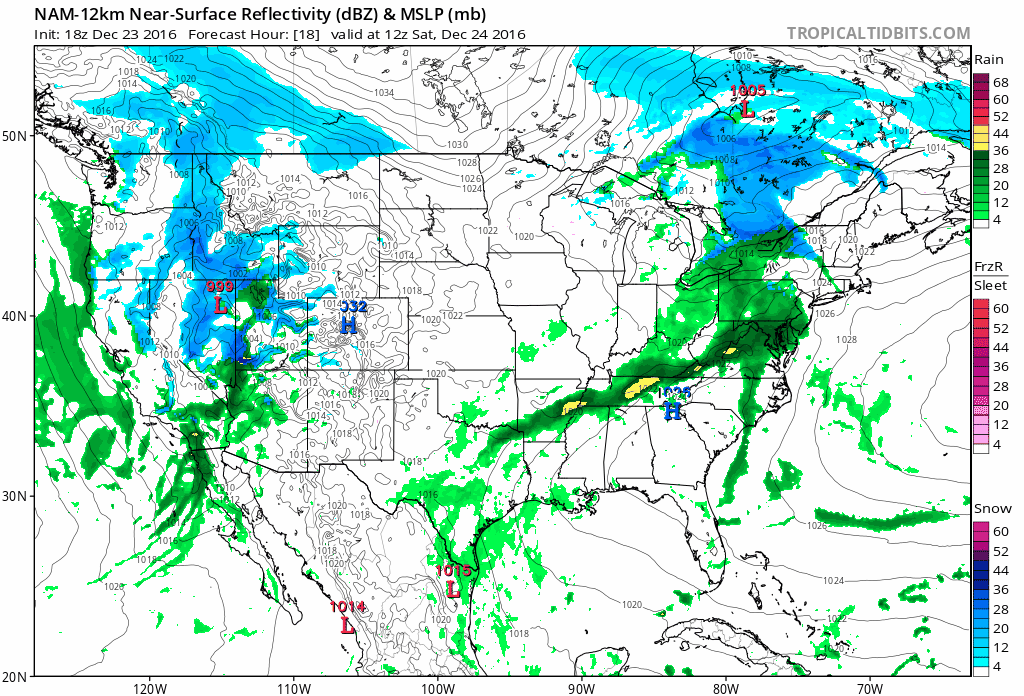
March-like: Ice, Rain and Thunder on Christmas Day
We will wake up to a white Christmas, for the first time in 3 years. But Santa needs to hurry up; by midday tomorrow he may have to ditch the sleigh and finish his route on a cherry-red wave runner.
According to the Twin Cities National Weather Service Sunday's heavy rain will be only the third significant Christmas Day rain event in recent decades. Not as wet as the 2.6 inches of water that fell on December 25, 1982, but an inch of liquid water may soak the MSP metro area Christmas Day, melting snow, clogging drains and slowing traffic.
Rain freezing on contact will ice up roads in the morning; by late afternoon the atmosphere may be unstable enough for T-storms with temperatures in the 40s. I know, bizarre.
A Blizzard Watch is posted for the Dakotas, with over a foot of snow for far northwestern Minnesota by Monday. Serious icing is possible from Alexandria to Brainerd and Duluth.
No travel problems today, and next week's cold front almost looks reasonable, compared to -20F on Sunday. Models hint at 35-40F on New Year's Eve.
Wishing you and yours a Merry Christmas!
GFS Future Radar guidance above: Tropicaltidbits.com.
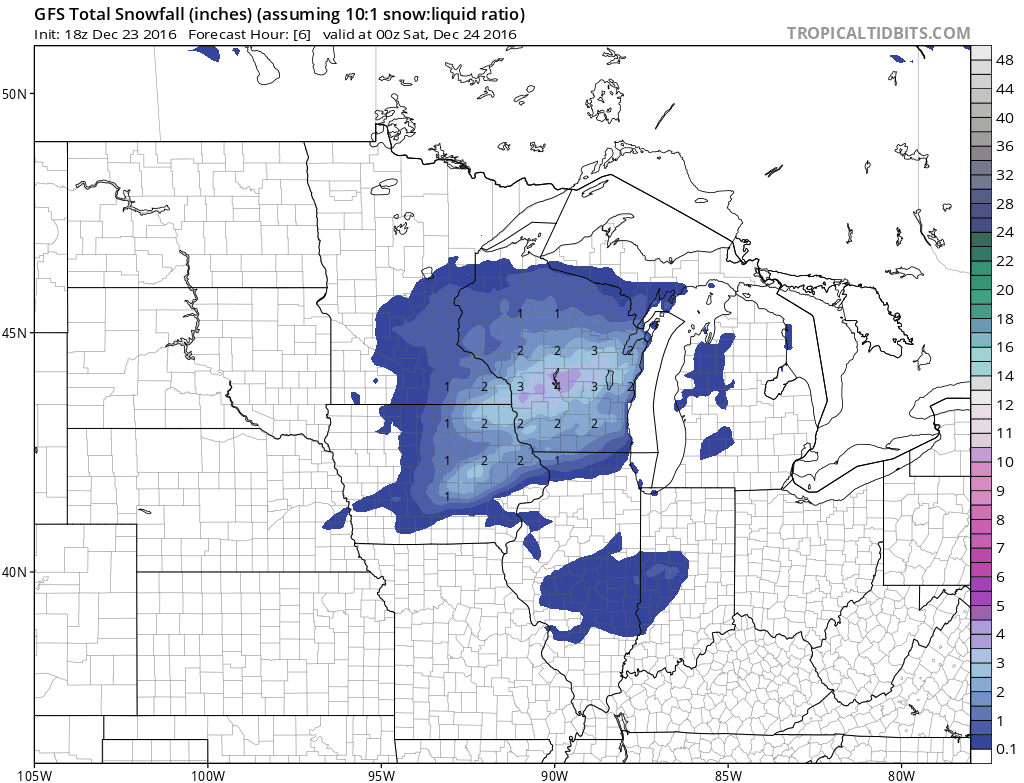
Christmas Day Snowfall Potential. The loop above shows GFS guidance and I suspect it's on the right track: blizzard conditions for the Dakotas and the Red River Valley with white-out conditions Sunday into Monday. A few inches may fall over central Minnesota with mostly rain south and east of St. Cloud. Map: Tropicaltidbits.com.
Aeris Weather Briefings: Issued Friday, December 23, 2016.
* Flash Flood Watch for Los Angeles; greatest risk is to burn areas - enhanced risk of flooding and mudslides.
* Christmas Day ice storm for Upper Mississippi Valley; heavy rain may spark minor flooding on highways and streams.
* Blizzard conditions possible across the Dakotas and far northwestern Minnesota Sunday into Monday morning.
* Isolated tornadoes can't be ruled out over the central Plains Sunday afternoon.
* Typhoon Nock-ten heading toward Philippines; Manila may see Category 1-2 impact on Christmas Day with torrential rains and power outages.







Summary: from flooding rains across California to heavy mountain snows over the Rockies, to Christmas Day ice across Minnesota and Wisconsin to blizzard conditions over the Dakotas by Sundayand a possible tornado outbreak over the central Plains, the latest storm pushing across the USA promises significant travel and facility disruptions timed for the holiday weekend. Meanwhile the Philippines is bracing for a potentially damaging typhoon, scheduled to track very close to Manila on Christmas Day.
Paul Douglas, Senior Meteorologist, AerisWeather
| RELATED | Record-Warm Autumn Solidifies 2nd-Hottest Year for U.S. 2016 Is Days Away from Sealing Record-Hot Spot Record Highs Could Outpace Lows 15-to-1 |
|---|
Those record-hot places can be found from coast to coast. They include medium-sized cities like Asheville, N.C., Modesto, Calif., and Flint, Mich., as well as lesser-known locales like Neosho, Mo., Callahan, Calif., and Climax, Colo. While some of the heat was driven by the super El Niño earlier this year, that alone doesn’t explain all the records being set, particularly in the latter half of the year after El Niño faded. Climate change has caused the U.S. average temperature to increase about 1.5°F since the 1880s..."
Animation credit: "Weather stations in the U.S. that are having a warmer than normal, colder than normal and record hot year."
Arctic Temperatures Soar to 30C Above Normal. That's close to 50F warmer than average. No, this isn't normal or "average". And what happens in the Arctic doesn't stay in the Arctic. Here's an excerpt from Canada's CBC: "...In fact, models — which Scambos says are "fairly generous" — anticipate an ice-free Arctic by the 2050s or 2060s, though it could happen sooner. "There's an inertia to the climate system," Scambos said. "We still are not seeing the world we're in for." David Phillips, senior climatologist with Environment and Climate Change Canada , said that instead of the air flow moving west to east, as it typically does, patterns are changing. Now there is more of a north-south interaction where warm air moves up from the south. However, the northern air can also dip further down, as we saw the past two weeks with unusually cold temperatures across the country. The change in air flow can cause the wild swings we are seeing more often. In this case, warm air over Greenland and Norway is being pulled up to the Arctic, causing the unusual weather..."
Photo credit: "The Arctic climate is changing, alarming climatologists." (CBC)
Image credit: Climate Reanalyzer.
Update...
Image credit: "Temperature near 89N latitude Dec. 20-22. (Data from North Pole Environmental Observatory buoy 300234064010010"
Image credit: "In this educational film, researchers explain the dangers residents face living near the area of the Campi Flegrei volcano, near the Italian city of Naples." (YouTube/UPStrat-MAFA)
Beijing Now Has "Smog Refugees". Mashable reports that at least 150,000 people have fled thick smog.
Update...
Blue Skies Return to Beijing, But Dangerous Smog Still Blankets Northern China. Reuters has the story: "Blue
skies returned to Beijing on Thursday after winds dispelled dangerously
high levels of air pollution that had blanketed the Chinese capital for
five days prompting a pollution red alert, but large parts of northern
China remain under choking smog. The Air Quality Index (AQI) in Beijing spiked to more than 400 overnight, but by morning had dropped to about 50. The
Beijing city government said it had lifted the red alert in place since
last Friday evening, meaning emergency restrictions on vehicle use and
construction would end..."
Photo credit: "A
man holds a child at the Houhai area as blue sky returns after winds
dispelled dangerously high levels of air pollution in Beijing, China
December 22, 2016." REUTERS/Jason Lee.
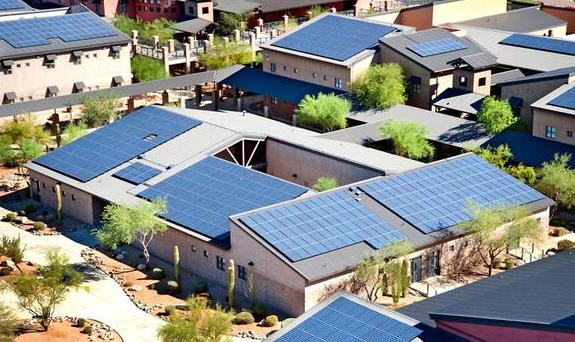
2 Remarkable Facts That Illustrate Solar Power's Declining Cost. Dave Roberts has an eye-opening post at Vox: "...Our
second remarkable fact is tucked away there on row five: Cutting edge
solar has nosed ahead of natural gas. Specifically, utility-scale,
thin-film solar PV plants produce cheaper power, on average, than new
natural gas plants. (“Thin-film” solar involves advanced materials other
than crystalline silicon, which has been the standard material for
solar panels for most of the history of solar.) Both onshore wind and
solar PV have seen insane drops in cost over the past eight years — 66
and 85 percent, respectively..."
File photo: Solar City.
A Good Investment? Yale Environment 360 has more perspective.
Photo credit: Inhabitat.com. "The fossil fuel tax is expected to bring in between 200 to 300 million euros ($220 to 440 million) of funding for the project."
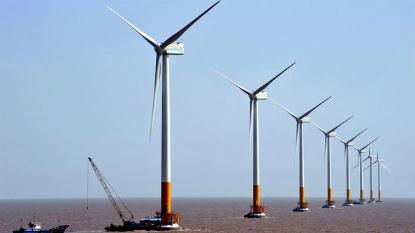
Why Is Corporate America Picking Wind Power Over Solar? The Guardian reports: "...Wind
energy has historically been much cheaper than solar, making it a more
attractive option, especially when energy can be a major expense for a
company. As more businesses come under pressure from their customers,
investors or government regulators to cut their greenhouse gas emissions
and help rein in global warming, they will be looking for low-carbon
energy that can compete with the price of coal and natural gas. Wind and
solar are not the only sources of electricity with lower carbon
footprints than coal and natural gas. Hydropower and nuclear are too,
and, unlike solar and wind, are able to produce electricity any time.
But hydropower plants require access to ample sources of surface water. A
nuclear power plant can take longer to secure permits and cost more than building other types of power plants..."
Businesses and States Are United on Clean Energy. Forbes has an Op-Ed that resonated: "...You
may not know it from the headlines, but Washington is not the only
energy game that matters these days. Companies that buy massive amounts
of energy and states that set the policies that shape the energy mix of
their economies – whether with clean energy or climate-warming fossil
fuels – also play a major role. Corporate and state efforts are driving
the country’s extraordinary progress in growing the economy while
reducing carbon pollution. Since 2000, according to the Brookings Institute,
the U.S. GDP has grown by 30 percent while carbon pollution has fallen
10 percent. And, judging from business and state actions in recent
weeks, interest in using more renewable energy and energy efficiency is
getting stronger and shows no sign of abating..." (Image credit: Climate Reality).
7 of the 10 Drunkest Cities in America Are All In a Single State. Oh really? Foodandwine.com has the story: "Around
here we like good beer, we like good wine, we like good cocktails, and
we certainly have had occasion to drink a few too many of those things.
But imbibing to excess is a serious matter and the list released over
the weekend from 24/7 Wall Street and
compiled using data from the Robert Wood Johnson Foundation and
University of Wisconsin Population Health Institute isn’t a top 10
anyone necessarily wants to be a part of. What that data showed was that
7 of the top 10 and 12 of the top 20 cities most inclined to binge are
in the state of Wisconsin..."
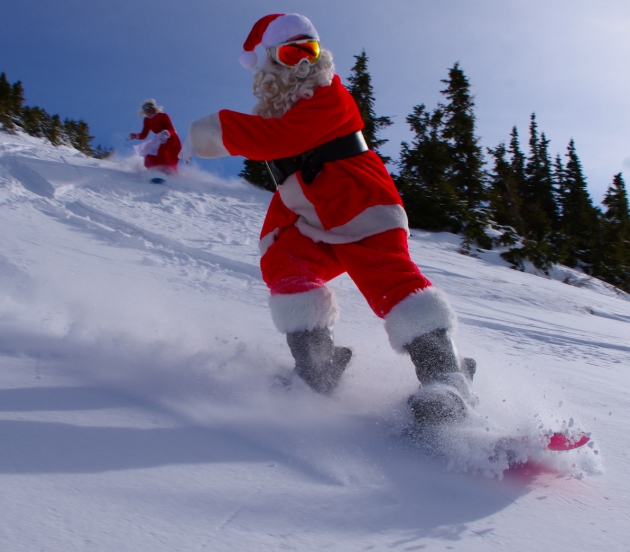
CHRISTMAS EVE: Mostly cloudy, dry - no travel problems. Winds: NE 3-8. High: 32
SATURDAY NIGHT: Overcast, milder than average. Low: 29
CHRISTMAS DAY: Icy start. Gusty, heavy rain, thunder. Winds: SE 20-40. High: 43
MONDAY: Gusty winds, flurries taper with falling temperatures. Winds: NW 20-40+ Wake-up: 31. High: 34
TUESDAY: Partly sunny, seasonably chilly. Winds: W 5-10. Wake-up: 18. High: 29
WEDNESDAY: Clouds increase, milder. Winds: SW 10-15. Wake-up: 21. High: 35
THURSDAY: Mostly cloudy with a few flakes. Winds: NW 15-25. Wake-up: 22. High: 27
FRIDAY: Plenty of sunshine, good travel. Winds: NW 10-15. Wake-up: 16. High: 26
CHRISTMAS DAY: Icy start. Gusty, heavy rain, thunder. Winds: SE 20-40. High: 43
MONDAY: Gusty winds, flurries taper with falling temperatures. Winds: NW 20-40+ Wake-up: 31. High: 34
TUESDAY: Partly sunny, seasonably chilly. Winds: W 5-10. Wake-up: 18. High: 29
WEDNESDAY: Clouds increase, milder. Winds: SW 10-15. Wake-up: 21. High: 35
THURSDAY: Mostly cloudy with a few flakes. Winds: NW 15-25. Wake-up: 22. High: 27
FRIDAY: Plenty of sunshine, good travel. Winds: NW 10-15. Wake-up: 16. High: 26
Climate Stories...
Photo credit: "Scientists hold signs during a rally in conjunction with the American Geophysical Union's fall meeting Tuesday, Dec. 13, 2016, in San Francisco." (AP Photo/Marcio Jose Sanchez).
Photo credit: Bethany Legg via Unsplash.
Photo credit: "The energy system and the tax system have got to be simplified in a way that everybody understands and doesn’t allow the wealthy few to completely rig the system," says Hansen." Benedict Evans/Redux.
Ignoring Climate Change Just Got More Expensive. Here's an excerpt from Bloomberg: "...Nordhaus recently updated DICE. He published results of an early test-drive of it this week in a National Bureau of Economic Research working paper, titled “Projections and Uncertainties About Climate Change in an Era of Minimal Climate Policies.” Readers of recent headlines might be forgiven for assuming the “era of minimal climate policies” referred to is about the next four years. In fact, Nordhaus suggests, the “minimal policy” era is the one we’re currently in. (Nordhaus couldn’t be reached for comment.) The paper’s findings “pertain primarily to a world without climate policies, which is reasonably accurate for virtually the entire globe today,” he writes. “The results show rapidly rising accumulation of CO2, temperature changes, and damages...”
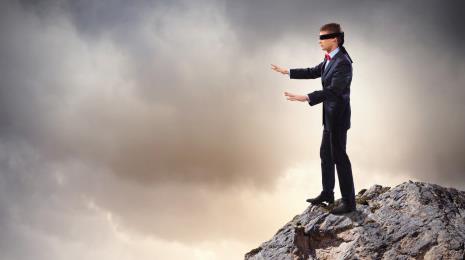
Photo credit: "Franz Josef Glacier in New Zealand, one of the glaciers whose retreat is almost certainly linked to global warming." Credit: Christopher Chan/flickr
Beliefs About Climate Change May Reflect a Failure to Understand What Climate Change Is. Here's a snippet from Forbes: "...The researchers found that over the 50 year period, temperatures that favored local warming at a rate higher than would be expected to occur by chance were recorded at 49% of the weather stations included in the study. An additional 10% of the weather stations recorded temperatures that favored local cooling. Changes in local weather were reliably correlated with people’s belief about climate change. People who live in areas that have experienced more record high temperatures than lows are likely to believe climate change is happening. Conversely, people who live in areas that have experienced more record lows than highs are likely to believe climate change is not real..."
Map credit: "Temperature change in the US compared to average temperatures from 1901 to 1960." Credit NASA
No comments:
Post a Comment